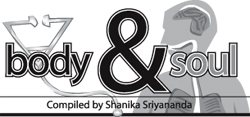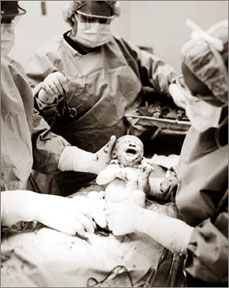|
observer |
|
|
|
|
|
OTHER LINKS |

|

|

|
C-sections, now expectant mothers' choice!
According to Ministry sources, the number of C-sections have gone up by 30 per cent compared to 10 years ago What Is Caesarean Childbirth? A major operation, each caesarean actually involves a series of separate incisions in the mother. The skin, underlying muscles and abdomen are opened first and then the uterus is opened allowing removal of the infant. There are two main types of caesarean operations, each named according to the location and direction of the uterine incision: * Cervical-a transverse (horizontal) or vertical incision in the lower uterus, and * Classical-a vertical incision in the main body of the uterus. Today, the low transverse cervical incision is used almost exclusively. It has the lowest incidence of haemorrhage during surgery as well as the least chance of rupturing in later pregnancies. Sometimes, because of foetal size (very large or very small) or position problems ( breech or transverse), a low vertical caesarean may be performed. In the classical operation, a vertical incision allows a greater opening and is used for fetal size or position problems and in some emergency situations. This approach involves more bleeding in surgery and a higher risk of abdominal infection. Although any uterine incision may rupture during subsequent labour, the classical is more likely to do so and more likely to result in death for the mother and fetus than a cervical incision. Why have Caesarean rates increased? Many factors account for rising caesarean birth rates. By the 1960's, increasing emphasis was being placed on the health of the foetus. With declining birth rates and couples having fewer children, even greater attention was given to improving the outcome of pregnancy, and infant survival in general. The nation's infant morality rate began to be seen as an international yardstick on the quality of health care. At the same time, advances in medical care combined to make maternal death from caesarean childbirth a rare occurrence. The safer the procedure became, the easier it was to decide to perform the operation. As a safe alternative to normal delivery, the caesarean became a practical way to try to improve the outcome of difficult pregnancies. Studies suggesting the benefit of caesarean birth in dealing with various pregnancy complications also led to more caesareans. Obstetricians came to favour surgery in pregnancies with difficult deliveries that formerly would have required the use of forceps. The diagnosis of "dystocia", a catch-all term meaning difficult labour, was made more frequently and handled more often with the cesarean operation. Foetal distress during labour a condition often resulting in a caesarean was more apt to be detected with the introduction of electric fetal monitoring. What is the single, most common reason for performing a Caesarean? Dystocia is a catch-all medical term covering a broad range of problems which can complicate labour. The consensus group found that this diagnosis was the largest contributor to the overall rise in the caesarean rate, accounting for 30 per cent of all caesareans. Included under the dystocia, or difficult labour, diagnosis are the following three basic types of problems which may impede labour: * abnormalities of the mother's birth canal, such as a small pelvis; * abnormalities in the position of the fetus, including breech position or large fetal size; and * abnormalities in the forces of labour, including infrequent or weak uterine contractions. Are there other medical conditions which would necessitate a Caesarean? Because of a need for early delivery, certain medical problems in either the mother or fetus can lead to caesarean birth. Examples include maternal diabetes, pregnancy-induced hypertension, vaginal herpes infection, and erythroblastosis fetalis, a blood disease related to the Rh factor in the mother. This entire group, however, contributes only a small part of the caesarean birth rate increases. The consensus panel said that in some of these situations vaginal birth would be a safe alternative if a more effective method of stimulating labour before term was available. The panel recommended research to develop such methods. What are the benefits of the Caesarean method? There are certain times when conditions in the mother or infant make cesarean delivery the method of first choice. By providing an alternate route of delivery, the procedure offers great benefit in situations when a vaginal delivery carries a high risk of complications and death. A caesarean is usually used when an expectant mother has diabetes mellitus. Such women have a high risk of having stillborns late in pregnancy. In these cases, a slightly early caesarean helps prevent this occurrence. The cesarean can also be a lifesaving procedure when the following conditions are present: * Placenta previa-when the placenta blocks the infant from being born. * Abruptio placentae-when the placenta prematurely separates from the uterine wall and haemorrhage occurs. * Obstructed labour-which can occur with a fetus in the shoulder breech, or any other abnormal position. * Ruptured uterus. * Presence of weak uterine scars from previous surgery or caesarean. * Fetus too large for the mother's birth canal. * Rapid toxemia-a condition in which high blood pressure can lead to convulsions in late pregnancy. * Vaginal herpes infection-which could infect an infant being born vaginally, and lead to its eventual death. * Pelvic tumors-which obstruct the birth canal and weaken the uterine wall. * Absence of effective uterine contractions after labor has begun. * Prolapse of the umbilical cord-when the cord is pushed out ahead of the infant, compressing the cord and cutting off blood flow. What are the maternal risks in Caesarean childbirth? The risks of any medical procedure are determined by examining the related mortality statistics showing death rates and morbidity figures showing complications, injuries or disorders linked to the event. These vary from hospital to hospital and from locale to locale. Although maternal death during childbirth is extremely uncommon, national figures show caesarean birth carries up to four times the risk of death compared to a vaginal delivery. The maternal mortality rate for vaginal delivery in 1978 was about 10 deaths per 100,000 births. For caesareans, the rate was about 41 deaths per 100,000 births. (In some cases, maternal deaths indicated in these figures were caused by illness rather than the surgery.) The morbidity rates associated with caesarean births are higher than with vaginal delivery. Because major surgery is involved, the chance of infection and complication is greater. The most common are endometritis (an inflammation of tissue lining the uterus) and urinary tract or incision infections. Are there risks to the infant? Infants delivered with elective caesarean surgery, especially if it is performed before the onset of labour, appear to have a greater risk of respiratory distress syndrome (RDS). This condition, in which the infant's lungs are not fully mature, may result if an error is made in estimating the age of the developing fetus. Under these circumstances, an infant who otherwise would have been healthy if allowed to develop fully encounters the problems of prematurity when removed too soon by caesarean. These include RDS and other lung disorders, feeding problems and various complications which is some cases require a long hospital stay. Measures and techniques to assess the maturity of the foetus and the degree of lung development are readily available in the United States. The consensus report stressed the need for improving physician and patient education about the safe and effective use of these techniques in planning for elective caesarean delivery. Respiratory distress is unlikely to be a problem, regardless of the type of delivery, if the infant is born at or near term. *** Religious and health aspects of circumcisionCircumcision is the means of cutting away of all or part of the foreskin (prefuce) of the penis. The practice is known in many cultures and it is performed either shortly after birth (e.g. among Muslims and Jews) or within a few years of birth or at puberty. For Jews it represents the fulfillment of the covenant between God and Abraham (Genesis 17: 10-14). That Christians are not obliged to be circumcised was first recorded Biblically in ACTS 15, although there is evidence that this ritual practice was deftly carried out on Jesus Christ as shown in a painting by famous artist Michael Pacho (1435-98) who was an Austrian painter and wood carver who worked mainly for local churches, carried out carving and painting of altarpieces and much of his work is still in situ. There is evidence to show that circumcision was also carried out on boys in ancient Egypt as shown in a famous relief in the tomb of Ankh-ma-hor, in the Saqqara cemetery at Memphis around 2345 BC. Feast of circumcisionThis is a Christmas festival (1 January) in honour of circumcision of Jesus eight days after his birth (Luke 1) Female circumcisionFemale circumcision or genital mutilation (clitoridectomy) is a ritual surgical procedure ranging from drawing blood to removing the clitoris alone, infibulation or Pharomi circumcision, removing the external genitals joining the sides and leaving a small opening. Now illegal, it dates to ancient times and purports to guard virginity and reduces sexual desire in traditional societies in many parts of the less developed world. Infibulation especially common in Sudan, Somalia and Nigeria is usually done by midwife and often in unhygienic conditions. It may lead to severe bleeding, infection, exquisite pain and death, of not urination and sexual intercourse can be painful and menstrual blood may be retained. Women are remfibilulated after childbirth. As mentioned earlier female circumcision is illegal in the West. Evidence regarding the purported medical benefits of circumcision (e.g. reduced risk of cancer) is inconclusive and the practice persists mainly for cultural reasons. Male circumcision may have arisen partly for reasons of hygiene. In hot arid conditions where water was scarce, it could prevent material accumulation under the prepuce resulting in balanitis. This could account for the tradition being in desert areas of the world, but being virtually unknown in communities living in tropical countries such as Sri Lanka. One eminent textbook of paediatrics concludes that there are virtually no medical or surgical reasons for performing this operation in the newborn infant. Yet recent research has revealed that the rate of HIV infection and possibly some other sexually transmitted diseases may be high in circumcised males. |

 The Caesarean sections which were performed only if necessary in the
past is on the increase today. It is according to health sources, not
the choice of the gynaecologists any longer but that the majority of the
pregnant women, prefer to avoid the traumatic experience of going
through a normal child labour.
The Caesarean sections which were performed only if necessary in the
past is on the increase today. It is according to health sources, not
the choice of the gynaecologists any longer but that the majority of the
pregnant women, prefer to avoid the traumatic experience of going
through a normal child labour. 








